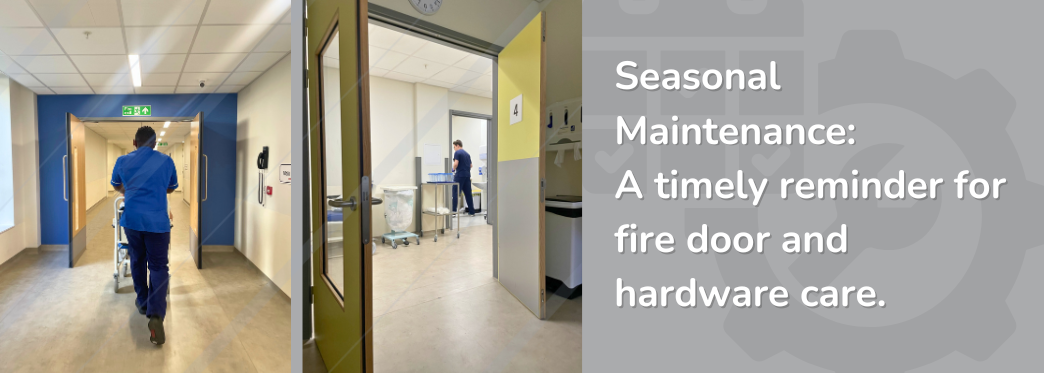


As the academic year comes to a close and summer holidays approach, facilities teams across schools, colleges, and healthcare environments prepare for the seasonal window (mind the pun) where essential maintenance can take place with minimal disruption. Among the critical priorities? Ensuring the long-term performance and compliance of fire doors and architectural hardware.
In environments such as schools and hospitals – where footfall is high and performance are paramount – door hardware is subjected to near-constant use. Over time, this can lead to wear that not only affects functionality but also compliance with fire and safety regulations.
At Consort, we’ve recently updated our Care and Maintenance of Finishes document – a quick-access guide for anyone responsible for maintaining ironmongery and ensuring it continues to perform and protect as intended and required. The document covers best practices across a wide range of finishes, helping to prolong the lifespan of the product and uphold fire safety standards.
Fire door inspections are now a legal requirement for residential buildings over 11 metres, as outlined in the Fire Safety (England) Regulations 2022. These rules mandate quarterly checks of communal fire doors and annual inspections of flat entrance doors – reinforcing the importance of regular maintenance. While the Fire Safety (England) Regulations 2022 apply specifically to residential buildings over 11 metres, non-domestic buildings such as schools and hospitals are still legally required to maintain fire doors under the Regulatory Reform (Fire Safety) Order 2005. Though no fixed intervals are mandated, routine inspections are expected, and best-practice guidance (such as BS 9999 and BS 8214) recommends scheduled checks — often every 6 months or more frequently in high-traffic areas. The summer break offers a practical window to carry out these inspections, address any faults, and document compliance ahead of the busy autumn term.
While our guide covers different metal finishes – we wanted to discuss some of the common door types and key considerations when dealing with maintaining your hardware.
Educational and healthcare facilities typically feature a broad range of door types – each with its own functional demands. In schools, you’ll often find solid-core timber doors on classroom entrances, FD30 or FD60-rated fire doors in corridors and stairwells, and robust metal or laminate-faced doors in service rooms and areas. In healthcare, doors may also incorporate hygiene features such as PVC facings or integrated vision panels to assist with safeguarding and infection control.
Each of these door types carries specific maintenance needs, especially where fire integrity and durability are crucial. Corridor doors, which are frequently propped open or subjected to repeated impact from foot traffic or equipment, are particularly vulnerable throughout the year of use. For these doors, checking the condition and alignment of door closers, hinges, finger guards and intumescent seals should form part of every summer maintenance routine.
Hinges: should be checked for wear at the knuckle and signs of misalignment. Accumulated grime and lack of lubrication (for non self-lubricating hinges) can cause unnecessary stress, leading to premature failure. It’s important to confirm that all screws remain tight and that the hinge itself remains CE or UKCA marked (if applicable for fire doors).
Levers or door handles: can loosen over time, particularly in high-use areas such as classrooms, toilets, or wards. Regularly inspect the fixings, ensure the return springs are functioning, and clean the hardware using a method appropriate for the finish – brass, stainless steel, or plated metals each require specific care, detailed in our guidance document.
Door Closers: another critical component, especially for fire doors. Check for oil leakage, inconsistent closing speeds, and ensure the arm is securely fixed. If the door slams or doesn’t close fully, it may need re-adjustment or replacement – issues that can compromise both user safety and compliance.
Finger Guards: essential in environments such as schools, nurseries, and healthcare settings. These components can be prone to tearing, cracking, or breaking over time – especially on doors that experience heavy daily use. Damaged or missing guards not only pose a safety risk but can also lead to non-compliance with duty-of-care obligations. Regular inspection is recommended, with replacements fitted promptly if deterioration is observed. Our finger guards are tested to 1,000,000 cycles, ensuring long-term performance under demanding conditions.
Kick plates and push plates: particularly those on heavy traffic doors, should be inspected for signs of lifting, sharp edges, or excessive scratching. These are simple to replace but play a crucial role in prolonging door life and reducing maintenance costs longer term.
The school summer break – and quieter periods within healthcare environments – represent strategic opportunity to carry out thorough inspections and remedial works. With fewer people on site, facilities teams can gain better access to key doors and carry out the necessary maintenance to ensure systems are functioning optimally before the new term begins or demand ramps back up.
Whether you’re overseeing an annual compliance review or simply want to ensure your hardware is up to standard, now is the time to act.
Our updated Care and Maintenance of Finishes document is designed to support specifiers, contractors, and estates teams alike. By following its recommendations, you can ensure your investment in quality ironmongery continues to deliver – both in performance and appearance.
You can view and download our Care and Maintenance document here.
If you’re planning a summer maintenance programme and want support in identifying at-risk areas or understanding the correct maintenance for your specific finishes, don’t hesitate to reach out to our team directly at [email protected]